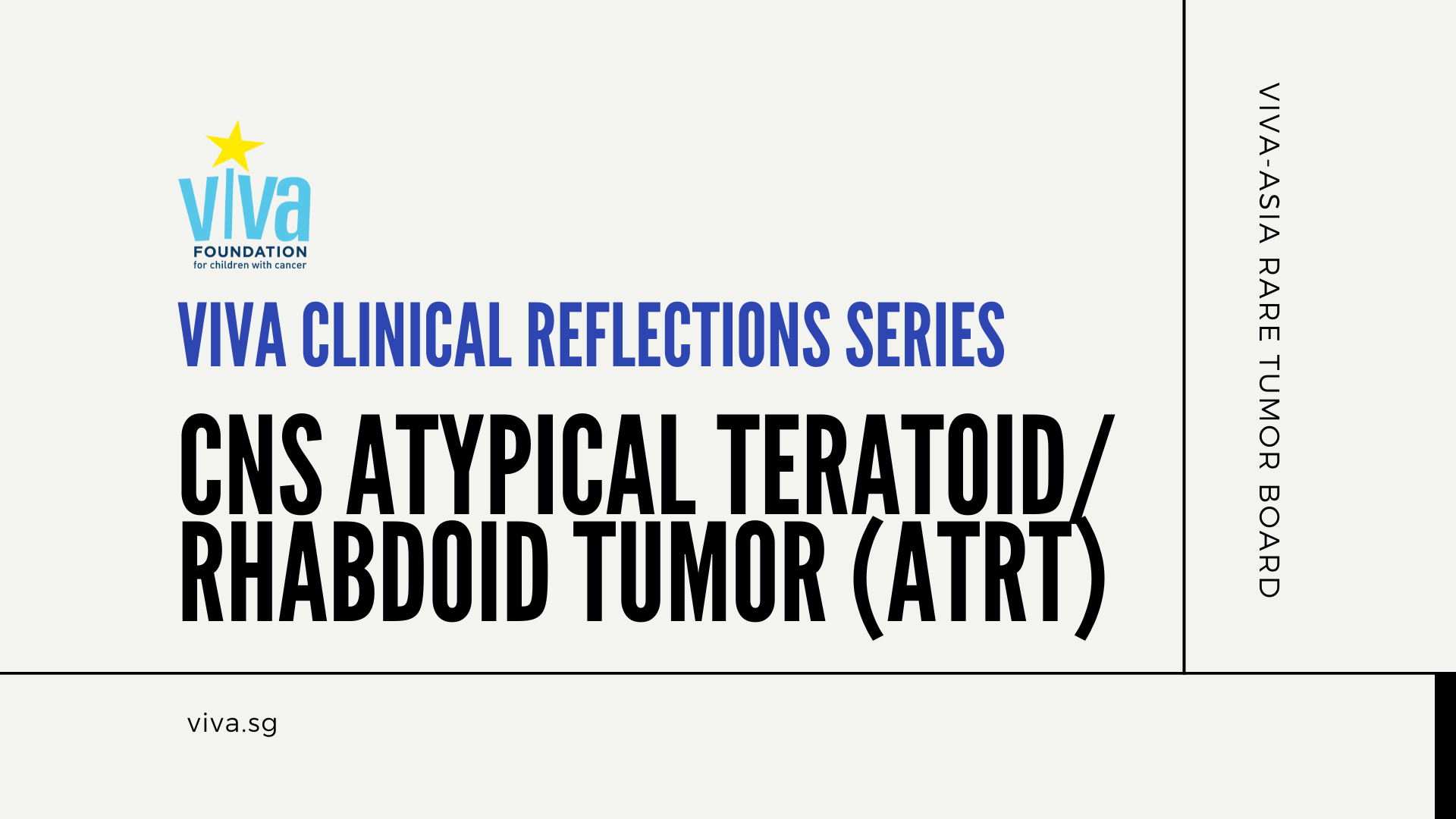
Synopsis of VIVA-Asia Rare Tumour Board Webinar
16 May 2024 | 8:00PM - 9:00PM
Introduction
Atypical Teratoid/Rhabdoid Tumor (ATRT) is a rare and aggressive central nervous system (CNS) malignancy that predominantly affects young children. Despite advancements in multimodal therapeutic strategies, the prognosis for ATRT remains challenging, with long-term survival rates estimated at approximately 40%. The tumor is characterized by the biallelic inactivation of SMARCB1 (INI1) or, less frequently, SMARCA4 (BRG1), both critical tumor suppressor genes. Recent molecular research has identified three distinct subgroups of ATRT—Sonic Hedgehog (Shh), MYC, and Tyrosine (TYR)—each exhibiting unique biological behaviors and influencing clinical outcomes. This review summarizes key insights into ATRT, including illustrative case studies, current treatment paradigms, and emerging therapeutic avenues, drawing from recent expert discussions.
Illustrative Case Study: Recurrent ATRT
A complex case involved a 10-year-old boy diagnosed with CNS ATRT. The patient initially presented at 21 months with acute symptoms, including high fever and loss of consciousness. Imaging revealed a pineal tumor with associated infarct, leading to an initial misdiagnosis of a germ cell tumor. Following two cycles of chemotherapy, a second-look surgery suggested a Pineocytoma WHO grade 1. However, subsequent tumor proliferation in the 4th ventricle necessitated a gross total resection, with pathological analysis confirming a small cell malignant tumor. Definitive diagnosis of ATRT was established upon further review revealing INI1 loss.
The patient endured a protracted clinical course involving multiple treatment modalities, including chemotherapy, radiotherapy, and numerous surgical interventions, yet experienced several recurrences. By age 7, he had undergone five surgeries and six rounds of radiotherapy. At age 8, new lesions in the cerebellopontine angle prompted further surgical resection and focal radiotherapy. Subsequently, the patient was managed with the MEMMAT chemotherapy regimen, which incorporates metronomic agents (details of which typically include oral Thalidomide, Fenofibrate, Celecoxib, Etoposide, Cyclophosphamide; intravenous Bevacizumab; and intratubular Etoposide and liposomal cytarabine). Despite the recurrent nature of his disease, the patient has maintained clinical remission, prompting ongoing discussion regarding the optimal duration of MEMMAT therapy and subsequent strategies in the event of further progression.
Figure 1. MEMMAT Regimen
Review of Clinical Experience and Current Therapeutic Approaches
An 18-year retrospective analysis of 15 ATRT cases in Hong Kong revealed a long-term survival rate of only 21%, notably lower than the generally reported 40% in recent literature. This disparity may be partly attributable to variations in treatment intensity; for instance, only 13% of patients in this cohort received high-dose chemotherapy consolidated by autologous stem cell rescue, and only half received radiotherapy, often deferred due to the patients' young age (median age of 3 years).
This experience underscores the potential importance of early and aggressive intervention, including the consideration of focal radiotherapy for patients as young as 6 months. Treatment protocols for ATRT have evolved significantly. Early intensive regimens, such as the European ATRT-CNS pilot study of 2004 which incorporated intraventricular methotrexate and focal radiotherapy, have been followed by protocols aiming for reduced toxicity without compromising efficacy, including COG 99703 and ACNS0333. While these newer regimens have demonstrated comparable survival rates (40-50%) with improved toxicity profiles, the overall survival plateau indicates a pressing need for novel therapeutic strategies.
Figure 2. Pilot ATRT-CNS study 2004 from Germany
Figure 3 . North American Children’s Cancer Group 99703 treatment plan
Figure 4. Treatment outline for the Children’s Oncology Group ACNS0333 protocol
The Significance of Molecular Subgroups in ATRT Prognostication and Treatment
Molecular evaluation is increasingly recognized as indispensable in the management of ATRT. The three principal molecular subgroups—SHH, MYC, and TYR—demonstrate considerable heterogeneity in prognosis and therapeutic response. For example, the MYC subgroup is associated with a higher recurrence rate (approximately 70%), whereas the SHH subgroup has been linked to a more favorable initial prognosis, with some studies reporting 100% survival at six months post-treatment. However, survival rates can decline significantly by 12 months, emphasizing the necessity for treatment strategies tailored to specific molecular profiles.
Current treatment paradigms, heavily reliant on high-dose chemotherapy and radiotherapy, have improved survival but are associated with significant long-term sequelae, particularly in very young children. A more nuanced approach, potentially incorporating intrathecal chemotherapy and extended maintenance therapy, aims to mitigate the need for radiotherapy in select patients. For instance, a regimen employed at Toronto Sick Kids Hospital has shown a 60% 5-year event-free survival rate in their cohort, with 15 out of 25 patients successfully avoiding radiotherapy.
Figure 5. Clinical and molecular characteristics of ATRT subtypes
Emerging Therapies and Future Directions
Several novel therapeutic agents are under investigation for ATRT, including epigenetic modifiers, immune checkpoint inhibitors, and targeted agents such as Aurora A kinase inhibitors (e.g., Alisertib). To date, these therapies have demonstrated limited efficacy in CNS ATRT, often yielding only transient responses in a small fraction of patients. The intrinsic heterogeneity of ATRT, even within defined molecular subgroups, poses a significant challenge to the development of broadly effective targeted treatments.
A promising avenue is the application of minimal residual disease (MRD) monitoring via cerebrospinal fluid (CSF) analysis. This technique, analogous to approaches used in leukemia management, allows for real-time assessment of tumor response and has the potential to guide treatment modifications. MRD-based clinical trials are underway, aiming to establish standardized treatment regimens informed by molecular response rather than solely by radiological findings.
Key Considerations from Expert Consensus
Several critical points emerge from expert deliberations on ATRT:
- Collaborative Efforts: Given the rarity of ATRT, international collaboration is paramount for accumulating sufficient data to develop and validate effective treatment protocols.
- Radiotherapy Re-evaluation: While radiotherapy remains a component of ATRT treatment, its universal necessity, particularly in very young children, is being critically evaluated. Data suggest that a subset of patients may achieve long-term remission without radiotherapy, especially those who respond favorably to chemotherapy and exhibit no residual disease.
- Intraventricular Chemotherapy: The administration of intraventricular chemotherapy, notably methotrexate, has shown potential in controlling ATRT, particularly in patients with metastatic disease. The use of Ommaya reservoirs for facilitated administration and CSF monitoring is often recommended.
- Germline Alterations: The presence of germline mutations in SMARCB1 or SMARCA4 in a subset of ATRT patients may have prognostic implications, though the precise impact of these mutations varies and warrants further investigation.
- Management of Relapsed Disease: For patients experiencing ATRT relapse, aggressive management, including consideration of second-look surgery and intensive induction chemotherapy (e.g., the COG 99703 regimen, noted for its tolerability and efficacy in inducing remission), is often advocated.
Conclusion
ATRT remains a formidable oncological challenge characterized by aggressive behavior and historically poor long-term outcomes. Nonetheless, significant strides in understanding its molecular landscape, coupled with innovative approaches such as MRD monitoring and the investigation of novel targeted therapies, offer substantial hope for improving survival rates and mitigating treatment-related morbidity. The path forward necessitates robust global collaboration, the standardization of treatment protocols informed by molecular insights, and a continued commitment to elucidating the biological complexities of this devastating pediatric malignancy. The overarching goal is to transcend the current survival plateau and deliver more effective, personalized therapies to children afflicted with ATRT.
References
- Peyrl A, Chocholous M, Sabel M, et al. Sustained Survival Benefit in Recurrent Medulloblastoma by a Metronomic Antiangiogenic Regimen: A Nonrandomized Controlled Trial. JAMA Oncol 2023.
- Cohen BH, Geyer JR, Miller DC, et al. Pilot Study of Intensive Chemotherapy With Peripheral Hematopoietic Cell Support for Children Less Than 3 Years of Age With Malignant Brain Tumors. Pediatr Neurol 2015.
- Reddy AT, Strother DR, Judkins AR, et al. Efficacy of High-Dose Chemotherapy and Three-Dimensional Conformal Radiation for Atypical Teratoid/Rhabdoid Tumor. J Clin Oncol 2020.
- Hoffman LM, Richardson EA, Ho B, et al. Advancing biology-based therapeutic approaches for atypical teratoid rhabdoid tumors. Neuro Oncol 2020.
- Chi SN, Zimmerman MA, Yao X, et al. Intensive multimodality treatment for children with newly diagnosed CNS atypical teratoid rhabdoid tumor. J Clin Oncol 2009.
- Huang EC, Guzman MA, De Girolami U, Cibas ES. Cytologic characterization of atypical teratoid/rhabdoid tumor in cerebrospinal fluid. Cancer Cytopathol 2014.
To rewatch the webinar, please click the link below. https://forms.gle/RsDyyEmov35iTYPC8


